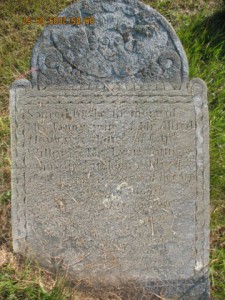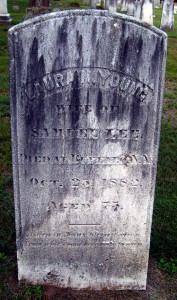
A practice I had utilized in a prior post, regarding New York state deaths appearing in Connecticut sources, has turned up in a new context. In the prior case, someone from Connecticut had died in New York, and her detailed death was recorded in a Connecticut newspaper, while no civil record of death was recorded locally, which is not surprising for New York State.
In this new case, I am working on an article for Mayflower Descendant on the Young family of Windham, Connecticut, which has descents from Mayflower passengers John Howland and Richard Warren. Several descendants are buried in Windham Center Cemetery, which has led to a few interesting scenarios in terms of finding information from gravestones. I’ll describe three below:
The first is the death of Zephaniah Young, who died at Windham 4 April 1782. His gravestone appears on Findagrave with these photos:
Obviously a lot of the stone is in the earth. However, in 1917, many of the stones in this cemetery were transcribed in the Register. Zephaniah appears below:
This stone had a lot more to say! I’m grateful this transcription was undertaken nearly one hundred years ago!
 Still others have stones which remain above the ground, but sometimes the photographs are just impossible to read. At right is the stone of Zephaniah’s sister Fanny, which was also uploaded on Findagrave.
Still others have stones which remain above the ground, but sometimes the photographs are just impossible to read. At right is the stone of Zephaniah’s sister Fanny, which was also uploaded on Findagrave.
I’m sure if I was physically at the cemetery, I could make out the stone. Thanks to the 1917 transcription, I don’t have to:
But not every stone in this cemetery was transcribed in the 1917 series, and not every transcription is perfect. A place I frequently check for Connecticut gravestones is the same Charles R. Hale Collection I had searched in my earlier blog post for newspapers. These transcriptions go well into the early twentieth century. They are on microfilm on our fourth floor, and are digitally available on Ancestry.com. Zephaniah and Fanny’s niece, Laura M. (Young) Lee, appears in the Hale Collection with her transcribed gravestone, which is also at Windham Center Cemetery:
 However in this case, that transcription did not tell the whole story, as her (legible) stone also appears on Findagrave. Obviously the Hale transcription left out the very useful information that Laura died in Buffalo, New York, despite having a gravestone in Windham, Connecticut.
However in this case, that transcription did not tell the whole story, as her (legible) stone also appears on Findagrave. Obviously the Hale transcription left out the very useful information that Laura died in Buffalo, New York, despite having a gravestone in Windham, Connecticut.
I am very grateful for the existing online forums that allow us to post pictures of gravestones to share, as many older stones of our ancestors may be not be around for much longer. However, sometimes we will need to rely on older transcriptions when information on the stones has been lost to time and the elements. And then sometimes we will need to go back to the cemetery, in case the transcription was incomplete.




We also have transcription records in Franklin County, Pennsylvania. These have been very helpful when photographing for Find A Grave. It is very important to add the tombstone inscription to the photo when posting it, as so many are illegible.
I have some familiarity with Hale headstones in Connecticut. I have transcribed selected Irish emigrant stones from a New Haven cemetery (St. Bernard) and have compared various colonial transcriptions in Norwalk (St. Paul). My understanding is that Hale transcribers (often WPA employees) were told to copy only the name, date and basic relationships (husband, wife, son, daughter), but not other information such as place of birth or additional relationships.
For instance, Irish stones sometimes recorded exact place of birth. On colonial stones, “relect” or widow is often just given as “wife.” Also, simple transcription errors are found in Hale. But If the stone has seriously deteriorated since the 1930s, the transcription may be the best source, however limited it may be.
The Godfrey Library in Middletown, CT has an ongoing project to take the Hale Transcriptions and match them to photos of the gravestones for all of Connecticut cemeteries. Many of them have been completed. Members of the Library have access to these databases
I am planning a trip this coming week (weather permitting) to a cemetery in Essex, VT. I’ve recently become aware that at least four generations of one of my lines are buried there, with collateral lines as well. I have been making use of FindAGrave to print out sheets to help me identify graves of my ancestors and their relatives. I am grateful to one researcher in particular who has painstakingly photographed as many of the gravestones as she could and posted on Find A Grave. She also included information about nearby stones (it is a large family plot), and copied the inscriptions where legible. Many of the stones are shale and have not weathered well. In addition, not long after she made these photographs, at least some of the stones were treated with some caustic or acid to “clean them”. The added photos of these stones make me cringe. Even in the photos, you can see the texture of the stone where the cleaning materials etched them. I am hoping that they are not in the kind of sad shape I’ve seen in some other stones so treated. My intent is to map them in the cemetery and identify the relationships. I am hoping to re-photograph in different light conditions that may bring out more of the inscriptions, and verify what she had captured. I agree wholeheartedly that transcriptions are invaluable, especially in cases like this. One of my stops before I go to the cemetery will be the library across the street to see if, as in my town library, there are books of transcriptions from earlier times.
Once, while visiting in England, I saw an old tombstone of a man with each of his 3 wives mentioned on his tombstone with their births and death dates. Now, that was helpful!
While documenting my wife’s HUSSEY family I found a Hussey grave stone located in a rural Maine cemetery. I debated as to the probability that this was, actually, a memorial stone and not a true burial marker since George Hussey died during the US Civil War. Eventually, I located a letter from his company sergeant that described his death and noted that his personnel items were returned to his family. The inference being that George was buried where he died-in a farm field. Further research lead to the discovery that his remains were recovered in the 1870’s and were reburied in the the Antietam National Cemetery. Not all grave stones are actual grave markers.
I have done significant work for a family association having to do with transcriptions from stones – transcriptions are just that – what is written on the stone. IF the extra information is available to the person who transcribes the stone, that is nice and the info can be included. Find A Grave initially made the demand that only what is written there should be entered into FAG. Most people began adding information (surnames, places of birth, etc) as time has passed. Unfortunately, with transcriptions, we rely on the person doing the transcription to be of good eyesight. That isn’t always the case. I have found errors, because the inscription was not clear. If cleaning of the stone is necessary, it should be done by someone who knows what they are doing – use of the wrong chemicals or the wrong tools can create more damage and permanently. I have learned many useful tricks in taking pictures of headstones so that the inscription can be read. If you have the right software, you can download a picture and zoom in to see the inscription – that is if the resolution is good enough. There is almost always a way around it!
One of the problems with “Find A Grave” is that its transcriptions are often the research of an individual genealogist which make such a transcription no more (or less) useful than an online tree. Photographs certainly help divide original information from helpful additions.
Thank you for your blog. Those old listings of tombstones can be a huge help when stones have deteriorated.
My question is that you stated the information was in the “Registrar”. Just were is this and can it be accessed online? If so what is the URL? Thank you !
Jim, the “Register” is a our genealogical journal, short for the “New England Historical and Genealogical Register,” published since 1847. Here is the link to search this in our databases. http://www.americanancestors.org/search/advanced-search?category=Journals+and+Periodicals&database=New+England+Historical+and+Genealogical+Register&page=1
Chris, Thank you for the information and the URL. That was really helpful and I a, thankful the information.
Jim
Great info. I am very thankful to those who record the transcriptions and to those who take the photos. Both are so valuable. I was fortunate that a volunteer took photos of a family headstone ~and~ transcribed a lengthy epitaph for me too. It would have been impossible to discern from the photo alone.
I agree with Janice. These pictures mean so much to me and I am sure the rest of us as well. Please keep up doing the pictures and adding information when you can!
My Mayflower connection is thru Desire Fuller, daughter of Samuel Fuller, 2nd, Samuel Fuller 1st. Desire married John Taylor of New London, CT & Hebron, CT. Their son Benjamin Taylor married Abigail Dewey. Glad to share the rest of the descendants if interested with dates, sources, etc.